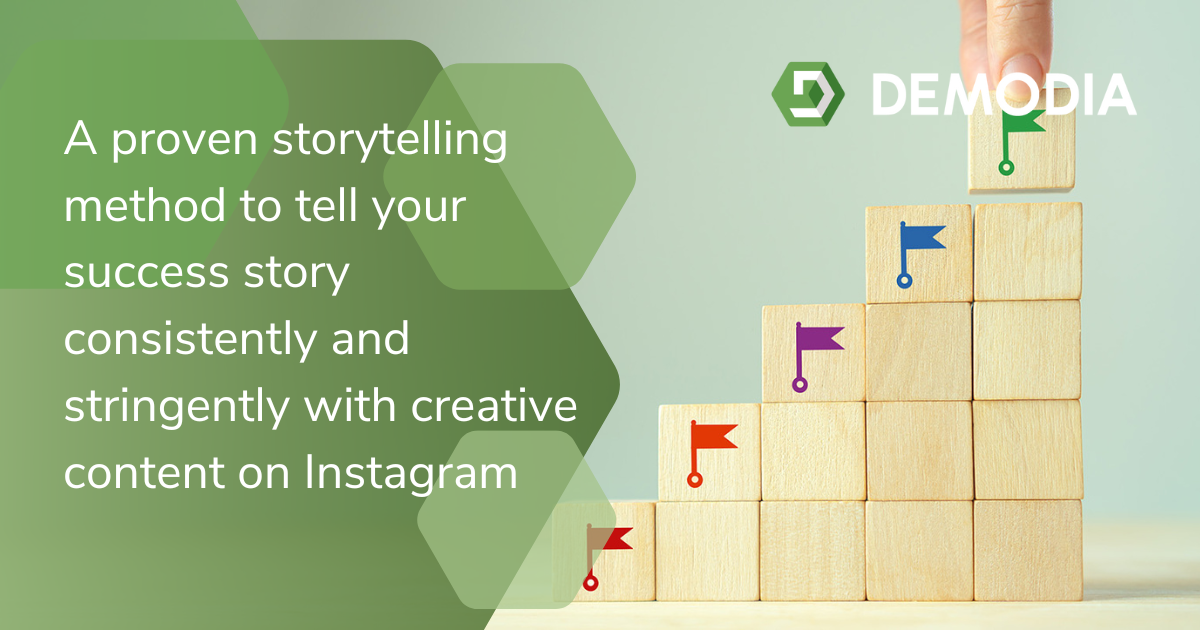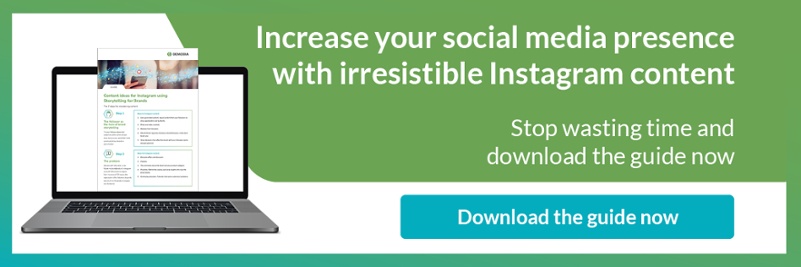7 steps for successful storytelling on Instagram

You want your brand to be seen and appreciated on Instagram. You want the work you put into your account to pay off. However, growing organically on Instagram today is much more effortful than it was a few years ago. More and more brands are putting a lot of effort into filling their Instagram channel with quality content and the algorithm seems to constantly give brands little opportunity to grow organically. There is a market-driven reasoning behind this: Meta wants to motivate brands to run paid ads.
Anyone who has to fill an Instagram channel with content on a daily basis knows the headache: what can be posted that fits the brand and still fascinates followers?
Storytelling solves this problem
Storytelling binds your followers to your brand because stories trigger emotions. Moreover, our brain is made to remember stories better than facts.
We recommend implementing both content and visual storytelling consistently:
Every post, no matter what form it takes - reel, photo or story - should consistently fit the brand story.
- Every post should tell a story in itself
- Every post should fit into the brand's visual identity
- To tell your brand story on Instagram, a brand must first define its storytelling.
At Demodia, we use a proven 7-step method to do this:
- The hero of the story is the customer, which on Instagram means the follower.
- The follower has a problem
- The brand is the guide who solves the problem
- The brand/guide has a plan to do this
- Calls the follower to a Call To Action
- Happy End: The mentor/brand shows the follower/client what their life will be like after the problem is solved
- Failure: What does the customer's life look like if the brand doesn't solve their problem?
After defining these 7 steps with our clients, we translate them into Instagram content.
Step 1: Followers as heroes of brand storytelling
Put your followers/potential customers at the centre of your story, because you want them to be convinced of your brand on your channel.
In Instagram content, this first step could be implemented like this:
- User-generated content: repost content from your followers to show appreciation and authority.
- Photo and video contests
- Ratings from followers
- Meet & Greet: Regularly introduce customers/followers, and invite them to join you.
- Share decisions that affect the brand with your followers (polls and get opinions)
Step 2: The problem
Ask yourself: why does a user follow my brand/product's Instagram account? What does he expect from my account? Of course, the expectation of the followers depends very much on the product category and the brand.
However, the following is true for all brands: followers expect added value for their attention and engagement. On Instagram, added value can be translated into content in the following ways:
- Exclusive offers and discounts
- Freebies
- Tips and tricks about the brand and your product category
- Proximity: Behind the scenes, exclusive insights into how the brand works
- Continuing education: Tutorials that solve customers' problems
Step 3: The brand as mentor solves problems
In storytelling for brands, the product or brand is the mentor who knows how to solve the followers' problem. For mentors, two aspects are crucial:
Empathy, because it is through empathy that we connect our brand emotionally with followers, and authority. So, what proves the credibility of your brand?
This step can be translated into content like this, for example:
- Awards / press mentions / speaker appearances.
- Certifications
- Before / after videos of the production process (understanding the customer process)
- Sharing the brand's learnings (demonstrating further development and customer proximity)
- Understand followers' problems, for example through Q&As
Step 4: The brand/mentor has a plan
Many brands put their product or themselves at the centre of storytelling. You will not be able to achieve lasting attention with this, because followers will only stay if it is clear to you what added value your behaviour has. As a mentor, you naturally know exactly how to solve your followers' problem. In addition to empathy and authority, above all you have the expertise: you have a plan. Translated into Instagram content, it can look like this:
- Tutorials: show how your product works.
- Answer questions from your followers
- Share product reviews
- Live demonstrations
- Step-by-step instructions
Step 5: Call to Action
No post should be without the call-to-action. Vary the call-to-action so your followers don't get bored. And don't be discouraged if followers take a while to follow your calls-to-action. Even if the likes and comments are slow in coming: Each Call to Action is stored in the memory and increases the chance that it will be followed the next time.
Here are some ideas for creative Calls to Action:
- Double click when you think storytelling works!
- Tag a friend who desperately needs this product!
- Write a comment with an emoji showing your reaction to this post!
- Tell us in the comments how you would use this product!
- Send us a direct message to get personalised advice!
Step 6: Happy ending
Storytelling always consists of at least 3 parts: Beginning - Middle - End. The ending has a special meaning, because it determines how we think about a story, what feelings the story triggered in us. Therefore, one of the key elements of storytelling for brands is to show the happy ending extensively. So: what does your customers' life look like when you have solved their problems. For example:
- Prizes, awards in connection with customer applications.
- Product reviews from customers
- Satisfied customer statements
- Sharing relevant statistics and data
- Before and after competitions
Step 7: Failure
In classic storytelling in blockbusters and literature, failure describes how far a hero can fall. The closer the fight against Apollo Creed gets, the clearer it becomes to Rocky how strong the champion is - doubts arise. In storytelling for brands, it makes perfect sense to show what happens when a customer abandons the product or brand, because studies have proven that we are motivated to act by negative consequences rather than positive outcomes.
On your Instagram channel, we have the following ideas for you to showcase the fallout:
- Videos telling customer stories (why I wasn't convinced at first).
- Comparative images in a carousel post
- Infographics showing what customers lose (time, money...) if you don't go for the product
- Before and after
- USG content: statements from customers who didn't use the product first
The ideas summarised, you can download in our ideas PDF. At Demodia, not only can we turn your story into content, but we're also masters of automation, so you can spend less time on your campaigns. Make an appointment with us today and we'll be happy to work out together how you can use your story to attract more customers while saving costs and time through automation.

